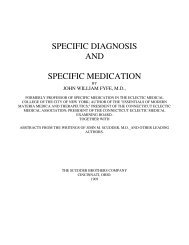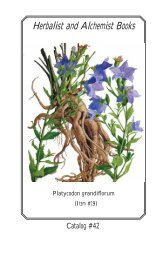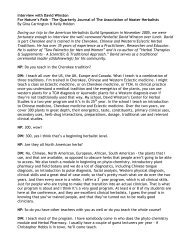MEDlCINAL PLANTS OF JAMAICA. PARTS 1 & 11.
MEDlCINAL PLANTS OF JAMAICA. PARTS 1 & 11.
MEDlCINAL PLANTS OF JAMAICA. PARTS 1 & 11.
Create successful ePaper yourself
Turn your PDF publications into a flip-book with our unique Google optimized e-Paper software.
MEDICINAL <strong>PLANTS</strong> <strong>OF</strong> <strong>JAMAICA</strong><br />
G. F. ASPREY AND PHYLLIS THORNTON<br />
PART II<br />
PALMAE<br />
A family, occurring mainly in the tropics, which includes many important economic plants such as the<br />
coconut, oilnut and date palms. Fats are common, especially in the endosperm of the seeds, together with<br />
mannan-like carbohydrates. Few glucosides, alkaloids, essential oils or resins are known.<br />
COCOS NUCIFERA L. Coconut.<br />
Coconut water, a favourite drink of Jamaicans, is said to be good for tbe bladder. It consists of a dilute<br />
solution of sugars and mineral salts with proteins and fats. In the fully grown but unripe nuts, called water<br />
coconuts, there is about 4.6 per cent. glucose. The coconut root is said to be astringent. In Lunan's time the<br />
outside shining part of the nut and 'branch' were scraped off as a fine powder which was used as a dressing for<br />
sores and ulcers. An emulsion of coconut oil was used for coughs. (15, 27).<br />
PAPAVERACEAE<br />
A family of some three hundred herbaceous and shrubby species which is well known for the presence<br />
of a great number of alkaloids including the opium alkaloids. Many species possess a milky latex. Fats are<br />
found in the seeds together with glycosides and many organic acids in combination with the alkaloids or<br />
minerals.<br />
ARGEMONE MEXICANA L. Mexican Poppy or Thistle: Prickly Poppy; Gamboge or Yellow Thistle.<br />
Steggerda reported that this plant is used for colds, especially in children. Browne also reported that it is<br />
sudorific when used in infusions and that the juice could be used for eye diseases. The seeds, in a dose of one to<br />
five, were used by the country people for diarrhoea and dysentery. It is reputed, by Lindley, that in the island of<br />
Nevis 'the oil obtained from the seeds is used as a substitute for castor oil'. The foliage contains the alkaloids<br />
berberine and protopine. No morphine is present. (5, 7, 8, 14. 15. 18, 25, 26, 27).<br />
PAPILIONATEAE*<br />
ABRUS PRECATORlUS L. Red Bead Vine: John Crow Beads; Crab's Eyes; Wild Liquorice; Liquorice Vine;<br />
Lick Weed.<br />
The root has long been used in India, Africa and the West Indies as a substitute for true liquorice. Seeds,<br />
leaves and roots contain a toxalbumin, abrin (ClzH140zNz) which is slowly absorbed from the gastro-intestinal<br />
tract. It is most concentrated in the seeds, which are fometic. purgative, anthelmintic and toxic. One to three<br />
grains of the powdered seeds boiled in milk are said to provide a tonic, though several writers report that one or<br />
two seeds are a fatal dose especially if chewed. The toxalbumin is said to be destroyed by cooking. The seeds,<br />
under the name of 'jequirity' have long been known for their effect in granular conjunctivitis. They are also said<br />
to contain a bitter amorphous substance, abralin (C13H1407)' Dalziel reports that the root has 1.5 per cent<br />
glycyrrhizine and the leaves 9 to 10 per cent.<br />
*See also LEGUMINOSAE







